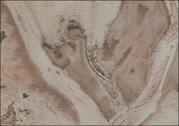 |
| New research says two rectangular structures seen in this satellite image may be the remnants of two temples from Atlantis (Image: Rainer Kühne) |
According to research reported by archaeology journal Antiquity, the fabled lost city of Atlantis could have been found in a salt marsh region off Spain’s southern coast.
The study, not yet peer-reviewed, is based on satellite images showing ancient ruins that seem to match descriptions made by the Greek scholar Plato, Discovery News reported.
Rainer Kuhne, a German scientist at the University of Wuppertal in Germany, says the description of Atlantis as an “island” simply refers to this part of Spain, which was destroyed by a flood between 800 and 500 B.C.
Plato’s dialogues “Critias” and “Timaios” make mention of two rectangular features visible in the satellite image. These features are believed to be two temples, one of which is for the god Poseidon; the other, devoted to Cleito and Poseidon.
“These rectangular structures are surrounded by concentric circles. This agrees with Plato’s description that the temples were surrounded by concentric circles of water and earth. Even the sizes are correct. According to Plato, the diameter of the largest circle was 27 stades, i.e. 5 kilometres. In the satellite photos, the diameter of the largest circle is between 5 and 6 kilometres,” Kuhne told Discovery News.
People have long searched for the fabled city of Atlantis since the story was told: from the Americas, to Asia, to Antarctica to the depths of the Atlantic ocean, to no avail.
Plato told of a city placed in front of Hercules – the Straits of Gibraltar – which flourished for more then 9,000 years. It was destroyed by the gods when its people became inclined to sin and corruption. Legend has it that an earthquake followed by a massive tidal wave sank the city in one night.
Kuhne concludes that “the Atlantean city and state may refer to a Spanish city, which was possibly destroyed by the Carthaginians during the 6th century B.C.”
* * *
You are welcome to print and circulate all articles published on Clearharmony and their content, but please quote the source.










 more ...
more ...